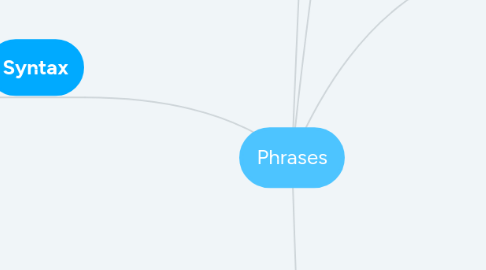
1. Syntax
1.1. Grammatical Catergories
1.1.1. Nouns
1.1.1.1. Number
1.1.1.1.1. Types
1.1.1.1.2. Features
1.1.1.2. Person
1.1.1.2.1. types
1.1.1.2.2. Forms
1.1.1.3. Gender
1.1.1.3.1. Types
1.1.1.4. Definiteness
1.1.1.4.1. Definite : the
1.1.1.4.2. Indefinite : a/an
1.1.1.5. Case
1.1.2. Pronouns
1.1.2.1. Number
1.1.2.2. Person
1.1.2.3. Case
1.1.2.3.1. Nominative : I, you, we, he, who
1.1.2.3.2. Genitive: my/mine, his, whose
1.1.2.3.3. Objective : me, us, you, him, whom
1.1.3. Verbs
1.1.3.1. Tense
1.1.3.1.1. Present
1.1.3.1.2. Past
1.1.3.1.3. Future
1.1.3.2. Aspect
1.1.3.2.1. progressive : action ongoing, in progress, incomplete
1.1.3.2.2. perfective : current relevant of past tense
1.1.3.3. Mood
1.1.3.3.1. Fact: indicative
1.1.3.3.2. non-fact
1.1.3.4. Voice
1.1.3.4.1. Active voice
1.1.3.4.2. Passive voice
1.1.4. Adjectives / Adverbs
1.1.4.1. Degree
1.1.4.1.1. Positive : beautiful, fast, quickly
1.1.4.1.2. Comparative: -er, more
1.1.4.1.3. Superlative : -est. most
2. Sentence
2.1. In terms of communicative function
2.1.1. Statement
2.1.2. Question
2.1.3. Command
2.1.4. Exclamation
2.2. In terms of clauses
2.2.1. Simple sentence
2.2.2. Compound sentence
2.2.3. Complex sentence
2.2.4. Compound-complex sentence
3. Clause
3.1. Dependent Clause
3.1.1. Types of subordinate clauses
3.1.1.1. The subject clause
3.1.1.2. The attributive clause
3.1.1.3. The predicative
3.1.1.4. The object clause
3.1.1.5. Several types of adverbial clauses
3.2. Independent Clause
3.3. Functions
3.3.1. Nominal Clauses
3.3.2. Adjectival Clauses
3.3.3. Adverbial Clauses
3.4. Elements: S, V, O, C, A
3.5. Types of clauses
3.5.1. Clause patterns: SV, SVC, SVA, SVO, SVOO, SVOC, SVOA
3.5.2. Verb phrase: finite, non-finite, and verbless clauses
3.5.3. clause connection: independent and dependent clauses
3.5.4. clause function: nominal, adverbial and adjective clauses
4. Phrasal structure
4.1. Noun phrase
4.1.1. definition: is constructed by a noun/ pronoun as the head and other constituents (optional) as modifiers.
4.1.2. Functions: Su, dO, iO, sC, oC, OP
4.1.3. Structure: Pre-Mod, Head noun, Post-Mod
4.1.4. E.g: N-> dogs, Det N-> the dogs, Det Adj N-> the large dogs...
4.2. Verb phrase
4.2.1. is constructed from a single verb or a combination of a main verb and any auxiliary verbs.
4.2.2. E.g: Call, calls, have been called...
4.3. Adjective phrase
4.3.1. a phrase with an adjective as a head
4.3.2. E.g: fierce, very fierce, fiercely barking...
4.3.3. Functions: Mod of N, sC, oC
4.4. Adverb phrase
4.4.1. A phrase works as an adverb in a sentence.
4.4.2. E.g: quickly, very quickly
4.4.3. Function: Mod of A
4.5. Prepositional phrase
4.5.1. consists of a preposition followed by a NP/ wh clause/ Ving clause
4.5.2. E.g: on the beach (Prep NP), from behind the door (2Prep NP), out from under the table (3Prep NP).
4.5.3. Functions: Mod of N, sC, oC, iO, pC
5. Verb complementation
5.1. Not all verbs can stand alone.
5.2. Verb
5.2.1. intensive
5.2.1.1. SVCs: He is lovely.
5.2.1.2. SVA (obligatory): He is out of the office.
5.2.2. extensive
5.2.2.1. intransitive
5.2.2.1.1. SV: He is crying
5.2.2.2. transitive
5.2.2.2.1. SVO: He broke the vase.
5.2.2.2.2. SVOO: He sent me an email.
5.2.2.2.3. SVOCo: He found the playing boring.
5.2.2.2.4. SVOA: He put the vase on the table.
